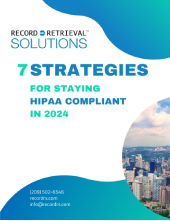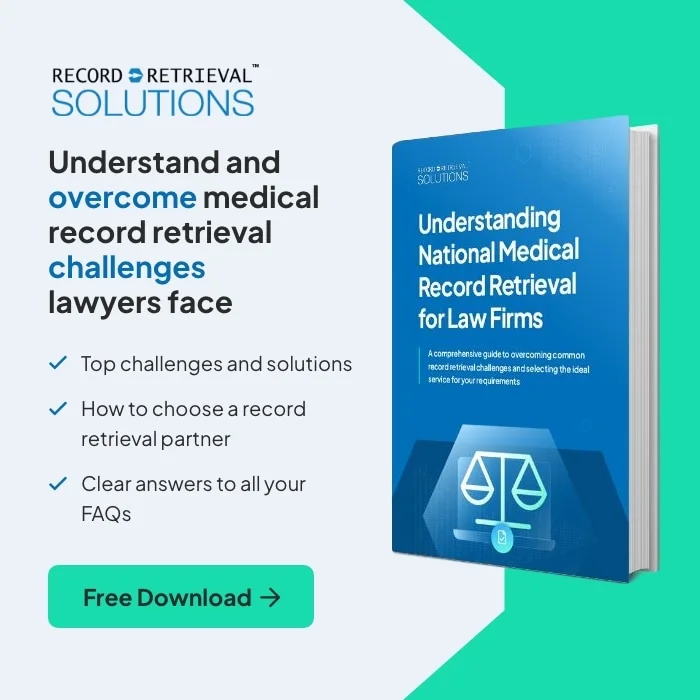Key Takeaways
- Multi-state litigation requires fast, compliant, and consistent medical record retrieval across different jurisdictions.
- Manual tracking creates bottlenecks—especially when providers vary by state laws, release timelines, and formats.
- Technology enables automation, audit trails, and real-time visibility, minimizing human error and delays.
- Record Retrieval Solutions (RRS) bridges the gap with its flat-fee model, RecordSync portal, and provider-specific workflows for faster turnaround.
Why Is Medical Record Retrieval So Complex in Multi-State Litigation?
When litigation crosses state lines, the challenge isn’t just collecting medical records—it’s navigating the differences in release procedures, consent laws, and turnaround timelines across multiple jurisdictions.
Law firms, insurers, and corporate legal teams often juggle hundreds of requests spanning providers in multiple states. Each has its own compliance nuances:
- Varying Health Insurance Portability and Accountability Act (HIPAA) interpretations
- State-specific release forms
- Different provider portal requirements
- Distinct fee structures and delivery methods
The result? Missed deadlines, inconsistent file formats, and record gaps can derail a discovery schedule or weaken case evidence.
That’s where technology steps in and where we transform chaos into consistency.
How Does Technology Streamline Multi-State Medical Record Retrieval?
Centralized Digital Portals Reduce Administrative Burden
Instead of tracking requests via email and faxed forms, cloud-based systems like RRS’s client portal provide a single, secure dashboard for all requests.
- One login, many states – Clients can submit, monitor, and download records from any jurisdiction in one place.
- Automated status updates – No need for manual follow-ups—users receive alerts when providers respond or deficiencies arise.
- Audit-ready logs – Every action is timestamped, maintaining a defensible chain of custody.
This digital consolidation eliminates duplication, reduces staff time, and ensures that every record follows a standardized process.
Intelligent Automation Speeds Up Multi-State Coordination
Manual coordination across states consumes hours. Technology automates repetitive steps so your legal team can focus on strategy, not paperwork.
RRS uses intelligent automation for:
- Pre-populated provider forms (auto-filled with patient and case data)
- Automated deficiency tracking that flags missing pages or signatures
- Digital reminders aligned with each provider’s average response timeline
These automations cut administrative time by up to 60% and reduce human error—essential for multi-state teams managing dozens of simultaneous subpoenas or authorizations.
Secure, Compliant Data Handling Across Jurisdictions
Each state enforces unique privacy regulations beyond federal HIPAA rules. Some require wet signatures; others demand notarization or unique consent language.
RRS’s HIPAA-compliant portal infrastructure accommodates those variations automatically:
- Dynamic templates match state-specific authorization formats
- Provider-specific workflows ensure the correct submission method (fax, portal, mail, or direct digital exchange)
- Secure encryption (both in transit and at rest) protects Protected Health Information (PHI) throughout the process
This means your firm doesn’t have to memorize every state’s compliance nuance—RRS already has it built in.
OCR and Indexing Turn Records Into Searchable, Usable Evidence
Raw medical records can slow down review teams. Optical Character Recognition (OCR) technology converts scanned images into searchable text, allowing you to instantly find critical terms such as diagnosis codes, provider names, and dates of service.
RRS enhances this with:
- Consistent file naming conventions for cross-state standardization
- Indexing and Bates stamping for eDiscovery compatibility
- Optional certifications for court-ready packets when required
With this digital preparation, your discovery process moves from reactive to proactive.
When Should Firms Switch From Manual to Automated Retrieval?
If your litigation portfolio spans multiple states—or even multiple providers in one case—the tipping point is clear: once your in-house team spends more time chasing records than analyzing them.
Signs it’s time to upgrade:
- Missed discovery deadlines due to provider delays
- Staff burnout from manual tracking
- Inconsistent formats are slowing eDiscovery
- Excessive courier or copy fees
RRS’s flat-fee model ($45 per request) and 15-day average turnaround time eliminate variable costs and timeline uncertainty —two of the most significant friction points for firms handling multi-state cases.
Why Partner With RRS for Multi-State Medical Record Retrieval
RRS isn’t just a vendor—it’s an extension of your litigation support team.
|
Challenge |
Traditional Retrieval |
RRS Advantage |
|
Multi-state variability |
Manual tracking per provider |
Provider-specific workflows & escalation rules |
|
Rising provider fees |
Per-page or platform charges |
Flat $45 per request, no surprises |
|
Delayed discovery |
Fragmented follow-ups |
Live deficiency logs + automated reminders |
|
Non-searchable files |
Scans only |
OCR + indexing for quick review |
|
Compliance risk |
Generic forms |
State-specific templates + audit trails |
RRS blends human oversight with advanced automation—ensuring accuracy, compliance, and speed at every step.
Conclusion
In multi-state litigation, the biggest challenge isn’t distance—it’s inconsistency. Every jurisdiction adds a layer of complexity that manual methods can’t sustain.
By integrating digital tools, automation, and compliance workflows, Record Retrieval Solutions simplifies the process end-to-end. You gain predictability, visibility, and confidence—across every case, every provider, and every state.
Ready to simplify your multi-state litigation workflow? Book a demo or contact us to see how fast, secure retrieval drives better case outcomes.
FAQs
What makes multi-state medical record retrieval more challenging than local retrieval?
Different state laws, provider systems, and consent requirements add complexity. Technology centralizes and standardizes those workflows to maintain consistency.
How does RRS ensure compliance across different state regulations?
RRS maintains provider- and state-specific authorization templates and submission rules, ensuring every request meets local and federal compliance standards.
Can RRS integrate with case management systems?
Yes. RRS integrates with leading litigation platforms, such as Filevine, for streamlined request submission, status tracking, and document upload.
What is the average turnaround time for RRS?
The RRS average is approximately 15 days, faster than the 25- to 30-day industry norm.
How does OCR help during litigation review?
OCR converts images to searchable text, making it easier for legal teams to find critical data quickly.






